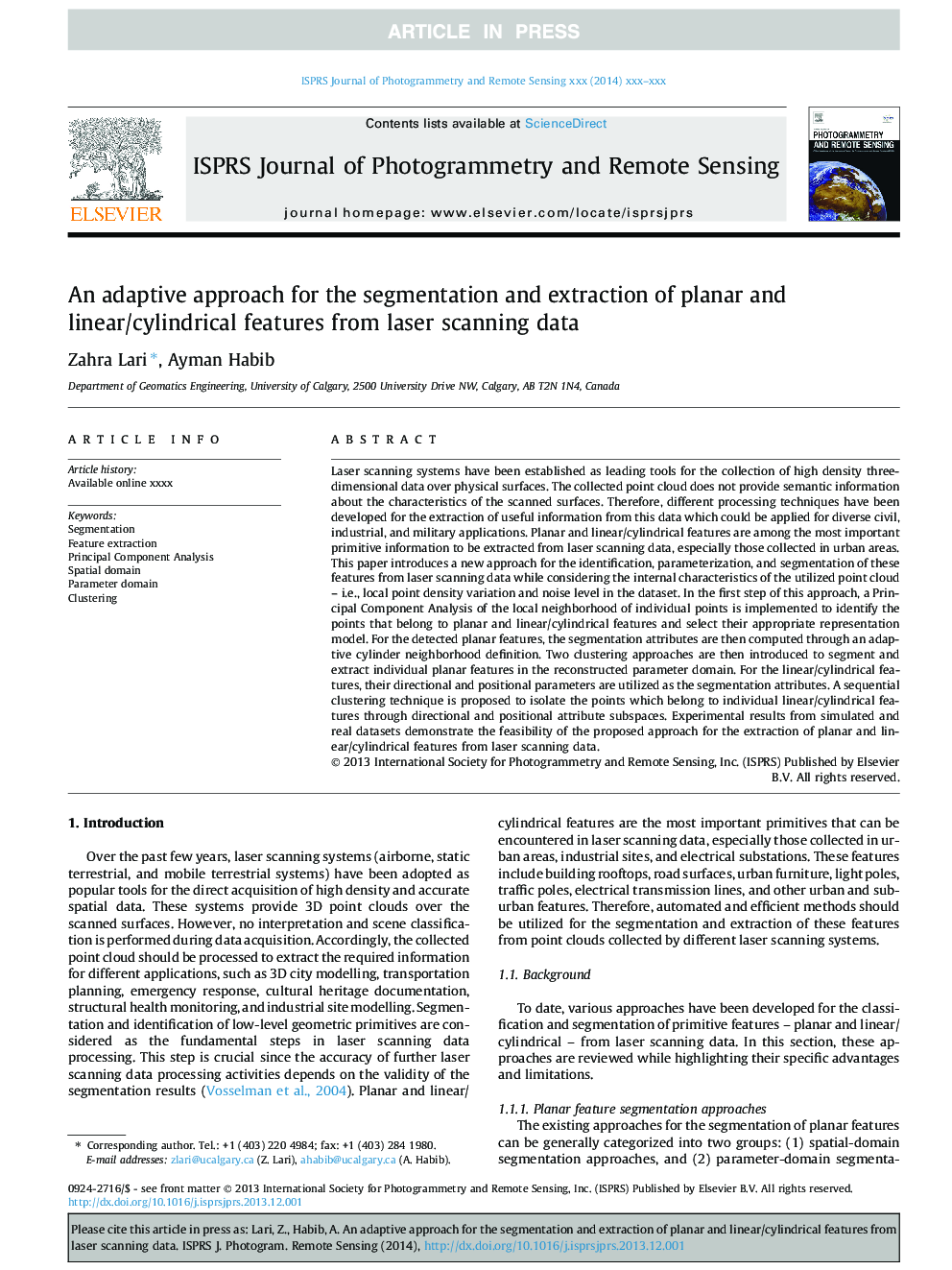| کد مقاله | کد نشریه | سال انتشار | مقاله انگلیسی | نسخه تمام متن |
|---|---|---|---|---|
| 6949665 | 1451281 | 2014 | 21 صفحه PDF | دانلود رایگان |
عنوان انگلیسی مقاله ISI
An adaptive approach for the segmentation and extraction of planar and linear/cylindrical features from laser scanning data
ترجمه فارسی عنوان
یک رویکرد انطباق برای تقسیم کردن و استخراج ویژگی های مسطح و خطی / استوانه ای از داده های اسکن لیزر
دانلود مقاله + سفارش ترجمه
دانلود مقاله ISI انگلیسی
رایگان برای ایرانیان
کلمات کلیدی
تقسیم بندی، استخراج ویژگی، تجزیه و تحلیل اجزای اصلی، محدوده فضایی، دامنه پارامتر، خوشه بندی
ترجمه چکیده
سیستم های اسکن لیزر به عنوان ابزار پیشرو برای جمع آوری داده های سه بعدی سه بعدی بر روی سطوح فیزیکی ساخته شده اند. ابر نقطه جمع آوری اطلاعات مربوط به ویژگی های سطوح اسکن ارائه نمی دهد. بنابراین، تکنیک های پردازش متفاوتی برای استخراج اطلاعات مفید از این داده ها وجود دارد که می تواند برای کاربردهای مدنی، صنعتی و نظامی متنوع باشد. ویژگی های پلاناری و خطی / استوانه ای از مهمترین اطلاعات اولیه است که از داده های اسکن لیزر، به ویژه آنهایی که در مناطق شهری جمع آوری شده، استخراج می شوند. این مقاله یک رویکرد جدید برای شناسایی، پارامتر کردن و تقسیم کردن این ویژگی ها از داده های اسکن لیزر را در نظر می گیرد، در حالی که با توجه به ویژگی های داخلی ابر نقاط بهره برداری شده - یعنی تغییرات تراکم نقطه ای محلی و سطح نویز در مجموعه داده ها. در مرحله اول این رویکرد، یک تحلیل مولفه اصلی محله محلی نقاط مختلف برای شناسایی نقاطی که به ویژگی های مسطح و خطی / استوانه ای تعلق دارند، اجرا می شود و مدل نمایندگی مناسب آنها را انتخاب می کند. برای ویژگی های مشخص شده فضایی، ویژگی های تقسیم بندی را از طریق یک تعریف محدوده سیلندر انطباق محاسبه می کنیم. سپس دو رویکرد خوشه بندی برای جداسازی و استخراج ویژگی های فردی در دامنه پارامتر بازسازی معرفی می شود. برای ویژگی های خطی / استوانه ای، پارامترهای جهت و موقعیت آنها به عنوان ویژگی های تقسیم بندی مورد استفاده قرار می گیرند. یک روش خوشه بندی متوالی برای جداسازی نقاط که متعلق به ویژگی های خطی / استوانه ای فردی است، از طریق زیرموضع ویژگی های موقعیت یابی است. نتایج تجربی از مجموعه داده های شبیه سازی شده و واقعی، امکان پذیری روش پیشنهادی برای استخراج ویژگی های مسطح و خطی / استوانه ای از داده های اسکن لیزر را نشان می دهد.
موضوعات مرتبط
مهندسی و علوم پایه
مهندسی کامپیوتر
سیستم های اطلاعاتی
چکیده انگلیسی
Laser scanning systems have been established as leading tools for the collection of high density three-dimensional data over physical surfaces. The collected point cloud does not provide semantic information about the characteristics of the scanned surfaces. Therefore, different processing techniques have been developed for the extraction of useful information from this data which could be applied for diverse civil, industrial, and military applications. Planar and linear/cylindrical features are among the most important primitive information to be extracted from laser scanning data, especially those collected in urban areas. This paper introduces a new approach for the identification, parameterization, and segmentation of these features from laser scanning data while considering the internal characteristics of the utilized point cloud - i.e., local point density variation and noise level in the dataset. In the first step of this approach, a Principal Component Analysis of the local neighborhood of individual points is implemented to identify the points that belong to planar and linear/cylindrical features and select their appropriate representation model. For the detected planar features, the segmentation attributes are then computed through an adaptive cylinder neighborhood definition. Two clustering approaches are then introduced to segment and extract individual planar features in the reconstructed parameter domain. For the linear/cylindrical features, their directional and positional parameters are utilized as the segmentation attributes. A sequential clustering technique is proposed to isolate the points which belong to individual linear/cylindrical features through directional and positional attribute subspaces. Experimental results from simulated and real datasets demonstrate the feasibility of the proposed approach for the extraction of planar and linear/cylindrical features from laser scanning data.
ناشر
Database: Elsevier - ScienceDirect (ساینس دایرکت)
Journal: ISPRS Journal of Photogrammetry and Remote Sensing - Volume 93, July 2014, Pages 192-212
Journal: ISPRS Journal of Photogrammetry and Remote Sensing - Volume 93, July 2014, Pages 192-212
نویسندگان
Zahra Lari, Ayman Habib,
